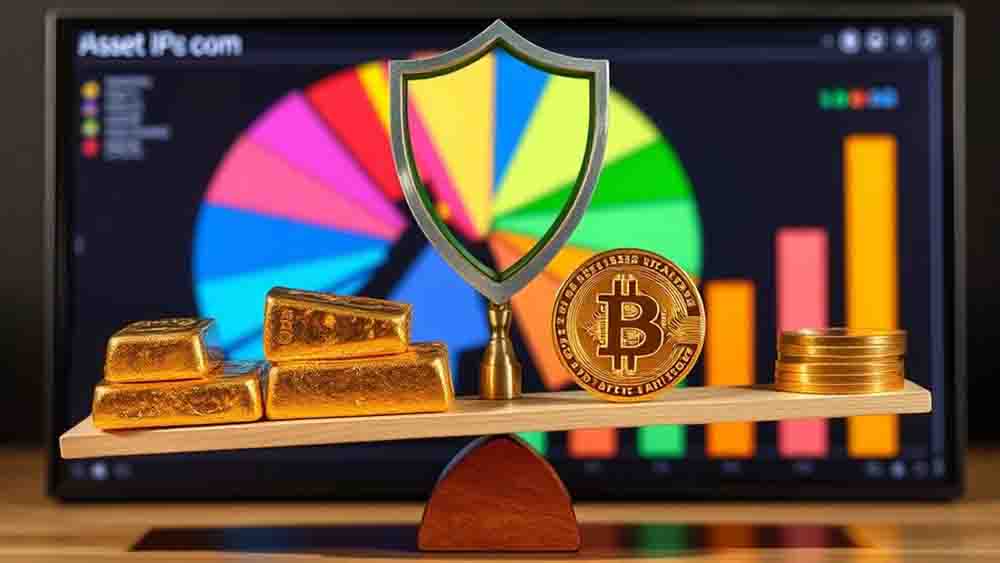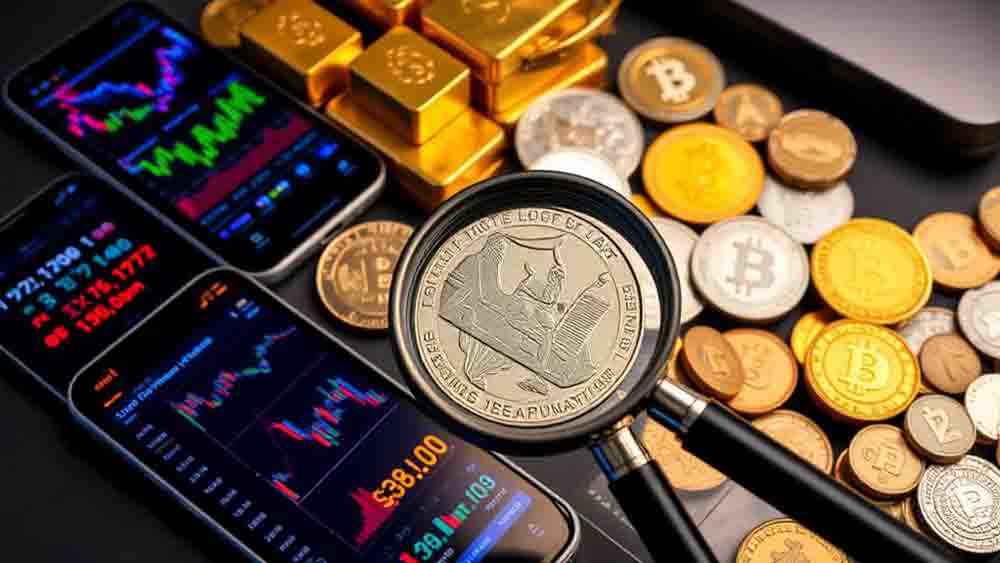Diversifying Wealth: Crypto and Precious Metal Strategies
Note: This post may contain affiliate links, and we may earn a commission (with No additional cost for you) if you purchase via our link. See our disclosure for more info. The gold and crypto world is constantly changing. This is not financial, investment, legal, or professional advice. So, please verify the information on the gold and cryptocurrency provider’s websites.
Click below and listen to the podcast on this page.
You're facing a financial landscape that's more complex than ever before. As traditional markets fluctuate and new digital assets emerge, you might be wondering how to safeguard and grow your wealth effectively. Cryptocurrencies and precious metals offer intriguing opportunities. But, they have risks and rewards. By learning how to combine these diverse assets, you'll be better equipped. It will help you navigate the choppy waters of modern investing. But what's the right balance, and how can you leverage these options to your advantage? The answers may surprise you.
Key Takeaways
- Allocate 5-15% of your portfolio to precious metals and diversify cryptocurrency investments across large-cap and small-cap coins.
- Implement a 70:30 ratio for gold to silver in precious metals and a 60:30:10 split for large, mid, and small-cap cryptocurrencies.
- Use dollar-cost averaging to reduce risks from price fluctuations in both crypto and precious metal investments.
- Consider tax implications, utilizing tax-advantaged accounts for precious metals and maintaining detailed records for cryptocurrency transactions.
- Regularly rebalance your portfolio every 6-12 months to maintain target allocation ratios and adapt to market changes.
Understanding Portfolio Diversification
Three key principles underpin portfolio diversification: risk reduction, enhanced returns, and stability.
When you diversify your portfolio, you're spreading your investments across various asset classes, including stocks, bonds, and precious metals. This strategy helps minimize the impact of poor performance in any single investment.
To achieve effective diversification:
- Allocate 5% to 15% of your portfolio to precious metals, based on your risk tolerance and financial goals.
- Include both traditional and alternative investments, such as cryptocurrencies and precious metals.
- Regularly rebalance your portfolio to maintain desired asset allocation.
Diversification offers several benefits:
- Reduces overall investment risk
- Enhances potential returns
- Provides stability during market downturns
For example, precious metals often have a low correlation with stocks, offering protection when equity markets struggle.
The Case for Cryptocurrencies
With the cryptocurrency market‘s explosive growth and increasing mainstream adoption, it's become a compelling option for portfolio diversification.
Cryptocurrencies offer unique advantages as digital assets, including potential for high returns and the ability to act as a store of value. The market's volatility presents opportunities for significant gains, with Bitcoin historically outperforming traditional asset classes.
Institutional investment in cryptocurrencies has surged, reflecting growing confidence in their long-term potential. Major companies adding Bitcoin to their balance sheets demonstrate the increasing acceptance of digital assets in corporate finance strategies.
Additionally, the rise of decentralized finance platforms has created new ways to generate passive income through crypto holdings.
Consider these key factors when evaluating cryptocurrencies for your portfolio:
- Market capitalization exceeding $1 trillion indicates substantial growth and adoption
- High potential returns, with Bitcoin showing annualized gains of around 50% in recent years
- Improving regulatory clarity globally, enhancing market legitimacy
As regulatory frameworks continue to develop, cryptocurrencies are becoming more accessible and attractive to a broader range of investors.

Gold's Enduring Value Proposition
Gold's reputation as a historical safe-haven asset makes it an attractive option for investors seeking stability in uncertain times.
You'll find that gold's ability to hedge against inflation can protect your purchasing power when currencies depreciate.
Historical Safe-Haven Asset
Throughout history, gold has proven itself as the quintessential safe-haven asset. Its enduring value proposition lies in its ability to maintain stability during economic downturns and geopolitical crises. As a long-term store of value, gold has consistently outperformed traditional commodities, offering an average annual return of 8.3%. This resilience makes it an attractive option for investors seeking to protect their wealth against market volatility.
Gold's unique characteristics make it an ideal tool for portfolio diversification and risk mitigation:
- Low correlation with stock market performance
- Retention of purchasing power during inflationary periods
- High liquidity and accessibility in various forms
During times of financial instability, you'll find that gold tends to retain its value, often rising in price as other assets falter. This inverse relationship with traditional markets makes it an effective hedge against economic uncertainty.
Additionally, gold's ability to preserve wealth during inflationary periods, as seen in the 1970s and late 2000s, underscores its importance in a well-rounded investment strategy. By incorporating gold into your portfolio, you can enhance your financial security and potentially safeguard your wealth against unforeseen economic challenges.
Inflation-Hedging Capabilities
Renowned for its inflation-hedging capabilities, gold continues to prove its worth as a strategic asset in wealth preservation. As a precious metal with intrinsic value, gold has consistently demonstrated its ability to retain value during periods of high inflation.
During inflationary cycles, gold has shown an impressive average annualized return of 8.3%, markedly outperforming traditional commodities.
Investors looking to protect their wealth from currency devaluation and loss of purchasing power often turn to gold as a reliable store of value. This was particularly evident during the 1970s, when soaring inflation rates coincided with substantial increases in gold prices.
As market dynamics shift and economic uncertainty rises, gold typically experiences price appreciation, reinforcing its role as a hedge against inflation.
When developing your investment strategy, consider incorporating gold to diversify your portfolio and mitigate inflationary risks. By aligning your financial goals and risk tolerance with gold's historical performance, you can potentially safeguard your wealth during challenging economic times.
Remember that gold's enduring value proposition lies in its scarcity and universal demand, making it a timeless asset for wealth preservation.

Portfolio Diversification Benefits
A cornerstone of intelligent investing, gold offers unparalleled portfolio diversification benefits that extend greatly beyond its aesthetic appeal. As a precious metal with low correlations to traditional assets, gold serves as a crucial component in well-balanced investment portfolios.
Its ability to stabilize volatility during economic downturns makes it an essential tool for wealth preservation and achieving long-term financial goals.
When you incorporate gold into your investment strategy, you'll benefit from:
- Enhanced portfolio stability due to gold's low correlation with stocks and bonds
- Improved risk management, especially during times of geopolitical uncertainty
- Effective protection against inflation, preserving your purchasing power
Experts recommend allocating 5% to 15% of your portfolio to gold and other precious metals, tailoring this percentage to your individual risk tolerance.
This strategic investment in precious metals can greatly boost your portfolio diversification, providing a buffer against market volatility. With gold's historical average annualized return of 8.3%, outperforming traditional commodities, it's clear that this precious metal offers both stability and growth potential for your investment portfolio.
Allocation Strategies for Balanced Portfolios
When building a balanced portfolio, you'll want to take into account ideal asset mix ratios that align with your financial goals and risk tolerance.
You can start by allocating 5% to 15% of your portfolio to precious metals like gold and silver, which act as a hedge against inflation and economic uncertainties.
For cryptocurrencies, aim to diversify across large-cap and small-cap coins, as well as various blockchain sectors, to potentially enhance your risk-adjusted returns while managing volatility.
Optimal Asset Mix Ratios
Carefully balancing your portfolio with an ideal mix of cryptocurrencies and precious metals can greatly enhance your wealth diversification strategy.
When diversifying your investment portfolio, consider allocating 5% to 15% to precious metals, depending on your financial goals and risk tolerance. This allocation can help manage volatility in your portfolio while providing a long-term store of value.
For your cryptocurrency investments, aim for a balanced approach:
- 60% in large-cap cryptocurrencies
- 30% in mid-cap cryptocurrencies
- 10% in small-cap cryptocurrencies
This distribution spreads risk while capturing growth potential. Additionally, allocating 10% to 20% of your crypto portfolio to stablecoins can provide liquidity and stability.
When incorporating precious metals, consider a 70:30 ratio of gold to silver. This ideal asset mix ratio capitalizes on gold's long-term value preservation and silver's industrial utility.
Remember, your investment horizon plays an essential role in determining the right balance for your portfolio.
To maintain your target allocation ratios and adjust for market fluctuations, rebalance your portfolio every 6 to 12 months. This regular maintenance guarantees your asset mix remains aligned with your financial goals and risk management strategy, maximizing your wealth diversification efforts.

Risk-Adjusted Return Analysis
Balancing risk and reward is at the heart of a successful investment strategy. When diversifying your portfolio with cryptocurrencies and precious metals, it's essential to conduct a risk-adjusted return analysis. This process helps you evaluate the potential gains of these volatile assets against their inherent risks.
To perform this analysis:
- Calculate the Sharpe ratio for both crypto and precious metal investments
- Compare their excess returns per unit of risk
- Assess how they align with your financial goals and risk tolerance
By incorporating both asset classes, you can create a diversified portfolio that potentially enhances long-term returns while mitigating risk. Aim to allocate 5% to 15% of your investment portfolio to precious metals, adjusting based on market trends and your risk profile.
Remember to:
- Regularly rebalance your portfolio to maintain ideal risk-adjusted returns
- Use dollar-cost averaging to reduce the impact of volatility
- Monitor economic indicators to inform your investment decisions
Risk Management Across Asset Classes
In today's volatile investment landscape, managing risk across diverse asset classes like cryptocurrencies and precious metals is essential for long-term financial success. By diversifying your portfolio between these two financial instruments, you can effectively mitigate market volatility and enhance your overall risk management strategy. Precious metals typically have a low or negative correlation with cryptocurrencies, helping to reduce portfolio volatility.
To effectively manage risk across these asset classes, consider implementing the following strategies:
- Use stop-loss orders for cryptocurrency investments to limit potential losses
- Secure precious metals through insurance and proper storage
- Regularly rebalance your portfolio to maintain alignment with market conditions
Understanding market dynamics is imperative for effective risk management. While geopolitical events often drive up precious metal prices, crypto markets may react differently to regulatory news. By staying informed about these factors, you can make more informed investment decisions.
Additionally, employing dollar-cost averaging for both crypto and precious metal investments can help mitigate the risks associated with price fluctuations. This strategy allows you to maintain a consistent investment approach over time, potentially reducing the impact of short-term market volatility on your overall portfolio.

Market Volatility and Hedging Techniques
Faced with the inherent volatility of crypto and precious metal markets, investors must master effective hedging techniques to protect their wealth. Market volatility can lead to significant price swings, especially in cryptocurrencies, necessitating strategies to mitigate investment risk.
Hedging Techniques:
- Options and futures contracts: These financial instruments can protect investments against adverse price movements in crypto markets.
- Stop-loss orders: Automatically sell assets when they reach a predetermined price, limiting potential losses in volatile markets.
- Dollar-cost averaging: Spread purchases over time to reduce the impact of price fluctuations.
Diversifying Your Portfolio:
Allocating 5% to 15% of your portfolio to precious metals can help mitigate overall investment risk. Gold, in particular, has historically served as a reliable hedge against inflation and currency devaluation.
As a store of value, gold prices often rise during periods of economic uncertainty and market volatility.
Consulting a financial advisor can help you develop a personalized strategy that balances the potential high returns of cryptocurrencies with the stability of precious metals.
Liquidity Considerations in Mixed Portfolios
A portfolio's liquidity can make or break its performance during market fluctuations. When diversifying your wealth between cryptocurrencies and precious metals, it's essential to evaluate how quickly you can convert these assets into cash.
Cryptocurrencies often provide higher liquidity due to 24/7 trading on multiple exchanges, while precious metals may require physical sale or specialized dealers. However, market conditions can impact liquidity for both asset classes.
To effectively manage liquidity in your investment portfolio, evaluate these strategies:
- Balance highly liquid cryptocurrencies like Bitcoin with less liquid precious metals
- Utilize exchange-traded funds (ETFs) for easier buying and selling of precious metals
- Monitor trading volumes of smaller altcoins to avoid significant price swings during low liquidity periods
Tax Implications of Diverse Investments
When diversifying your wealth across cryptocurrencies and precious metals, it's crucial to understand the tax implications of these investments.
Both asset classes are subject to capital gains tax, which can greatly impact your overall returns. The tax rate varies depending on how long you hold the asset, with long-term investments often benefiting from lower rates.
To optimize your tax strategy:
- Consider utilizing tax-advantaged accounts like IRAs or 401(k)s for precious metal investments, which can offer tax-deferred or tax-free growth.
- Keep meticulous records of all cryptocurrency transactions, as reporting requirements mandate disclosure of gains, losses, and trades to tax authorities.
- Be aware that like-kind exchange provisions, which historically allowed tax deferral on precious metal investments, may not apply to cryptocurrencies.
- If you're involved in cryptocurrency mining, remember that earnings are treated as ordinary income, while related expenses can often be deducted.
Future Trends in Wealth Preservation
As we look beyond current tax considerations, emerging trends in wealth preservation are reshaping investment strategies. The growing demand for precious metals and cryptocurrencies as financial assets reflects a shift in market trends and investor preferences.
To diversify your investment portfolio and protect against inflation, consider these key developments:
- The projected growth of the global precious metals market to $326 billion by 2027 underscores the increasing importance of gold and silver as safe-haven assets.
- Cryptocurrency adoption continues to rise, with over 300 million users reported in 2023, indicating a growing interest in digital assets for wealth preservation.
- Adding a 5-10% allocation of precious metals to a diversified portfolio can enhance risk-adjusted returns while reducing overall volatility during economic downturns.
As inflation rates surge and economic uncertainty persists, investors are increasingly turning to alternative assets to preserve wealth.
The combination of precious metals and cryptocurrencies in your investment strategy can provide a hedge against currency devaluation and offer potential for long-term growth.

Frequently Asked Questions
How to Diversify With Precious Metals?
To diversify with precious metals, you should:
- Allocate 5-15% of your portfolio to metals like gold and silver
- Consider physical bullion for tangible asset ownership
- Explore ETFs or mutual funds for easier exposure
- Monitor economic factors to guide your investment strategy
Precious metals offer a hedge against inflation and market volatility.
They've historically shown low correlation with traditional assets, helping stabilize your portfolio during downturns.
How to Diversify Your Crypto?
To diversify your crypto portfolio:
- Mix large-cap coins like Bitcoin with promising altcoins.
- Include various token types (stablecoins, utility tokens, governance tokens).
- Invest across different sectors (gaming, finance, DeFi).
- Spread investments among diverse blockchain protocols.
- Regularly assess and rebalance your holdings.
This approach helps you balance risk and growth potential while mitigating sector-specific risks.
It's essential to align your strategy with your risk tolerance and investment goals.
Remember to stay informed about market trends and adjust your portfolio accordingly.
How Much of Your Wealth Should Be in Precious Metals?
You should consider allocating 5% to 15% of your wealth to precious metals, depending on your risk tolerance and financial goals. This range aligns with typical financial advisor recommendations.
Precious metals can serve as a hedge against inflation and economic uncertainty. Your specific allocation should factor in your liquidity needs, tax implications, and overall investment strategy.
Remember to regularly monitor economic indicators and market trends, as these can influence the ideal percentage of your wealth to hold in precious metals.
Why Is It Good to Diversify Investments and Only Have 10% of Your Assets in Crypto Assets Binance?
Diversifying your investments and limiting crypto assets to 10% is a smart strategy.
You'll reduce your overall risk while still benefiting from potential crypto gains. This approach helps protect your wealth from the high volatility of cryptocurrencies.
By spreading your investments across different asset classes, you're less vulnerable to market fluctuations in any single sector.
Conclusion
You've learned that combining cryptocurrencies and precious metals can create a robust investment strategy. Allocate 5% to 15% of your portfolio to gold. Also, explore cryptocurrencies. This can boost growth and hedge against market volatility. Remember to take into account risk management, liquidity needs, and tax implications. As you move forward, stay updated on market trends. Adjust your strategy as needed. With this balanced approach, you're taking important steps toward long-term wealth preservation and growth.












One Comment